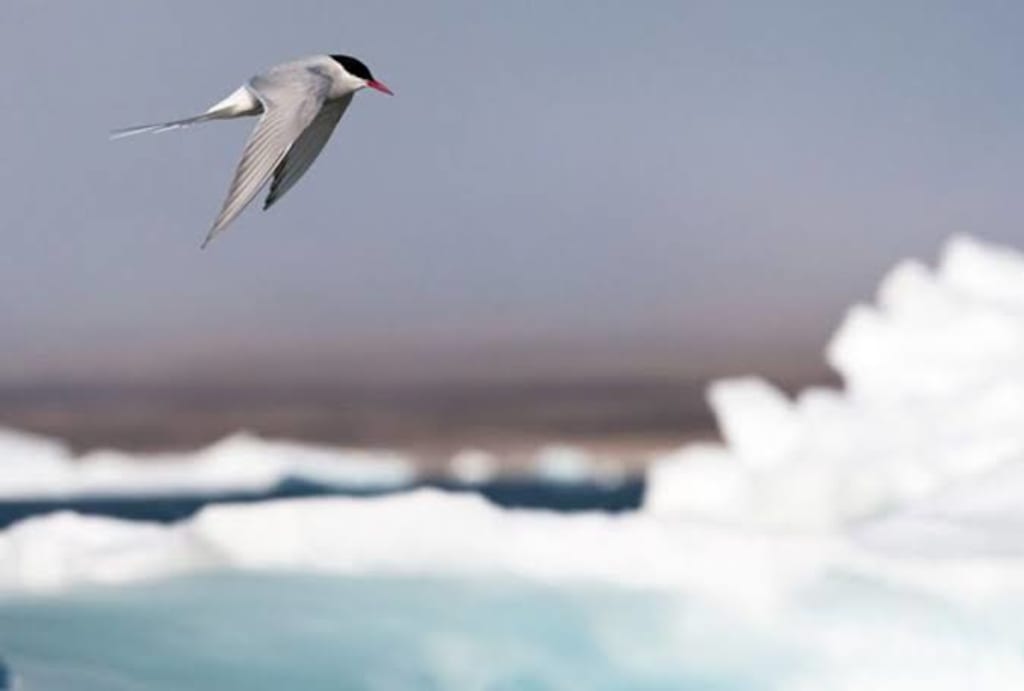The Long Distance Migration of Arctic Terns
Arctic Terns Nature’s Greatest Journey

The Arctic Tern (Sterna paradisaea) is known for its extraordinary migratory pattern, which covers vast distances and represents one of nature's most impressive feats.
This small seabird, weighing just about 100 grams, undertakes a biannual journey that spans from the Arctic to the Antarctic and back, covering a round-trip distance of approximately 70,000 kilometers.
This incredible migration is not only a testament to the resilience and endurance of the Arctic Tern but also provides invaluable insights into the broader ecological and environmental dynamics of our planet.
Understanding the Arctic Tern
Arctic Terns are medium-sized seabirds with a distinctive appearance. They have slender bodies, long pointed wings, and a deeply forked tail, which gives them an elegant and agile flight.
Their plumage is mostly white with a black cap, and their beaks and legs turn bright red during the breeding season.
These birds are primarily pelagic, spending most of their lives at sea. They feed mainly on small fish which they catch by plunging into the water.
Their breeding grounds are located in the Arctic and sub-Arctic regions, including parts of North America, Europe, and Asia.
Here, they nest in colonies on rocky shores, islands, and tundra.
The Migration Route
The Arctic Tern's migration is the longest of any bird species, and it follows a zigzag pattern rather than a straight line.
The journey begins at their breeding grounds in the Arctic. After the breeding season, usually around late August, they start their southward migration.
1. North to South Migration: Arctic Terns typically head southeast from their Arctic breeding grounds, following the coastlines of Europe and Africa or crossing the Atlantic Ocean to reach South America. Some terns may follow a more easterly route over the Indian Ocean.
2. Wintering Grounds: Their destination is the Antarctic, where they spend the southern summer (from November to March). During this period, they benefit from the abundant marine food sources in the rich Antarctic waters.
3. Return Journey: The return journey to the Arctic starts around April. This time, they often take a more westerly route, possibly following the coastlines of South America or traveling through the Pacific Ocean.
Navigational Prowess
The navigational abilities of Arctic Terns are nothing short of extraordinary.
They use a combination of environmental cues to navigate their long journey, including the position of the sun, the Earth's magnetic field, and visual landmarks.
Recent studies have shown that Arctic Terns may also use their keen sense of smell to detect specific oceanic smells associated with their migration routes.
These birds are also known to adjust their migration patterns in response to environmental changes, such as variations in wind patterns and food availability. This flexibility helps them to conserve energy and optimize their travel efficiency.
Ecological and Environmental Significance
The migration of Arctic Terns has significant ecological and environmental implications:
1. Indicator Species: As Arctic Terns travel across different marine ecosystems, they serve as indicators of ocean health.
Changes in their migration patterns can signal shifts in oceanic conditions, such as temperature changes, pollution levels, and food availability.
2. Biodiversity Connections: Their migratory routes connect diverse ecosystems, highlighting the interdependence of global biodiversity.
The presence of Arctic Terns in different regions underscores the importance of conserving marine habitats worldwide.
3. Climate Change: The Arctic Tern's migration is sensitive to climate change.
Rising temperatures and melting ice in the Arctic can affect their breeding habitats, while changes in ocean currents can impact their food sources.
Studying these birds provides valuable insights into the broader impacts of climate change on migratory species.
Conservation Challenges
Despite their remarkable resilience, Arctic Terns face several conservation challenges:
1. Habitat Loss: Coastal development, pollution, and climate change threaten their breeding and feeding habitats.
2. Human Disturbance: Increased human activity in coastal areas can disturb nesting colonies, leading to reduced breeding success.
3. Predation: In some regions, introduced predators such as rats and cats pose significant threats to eggs and chicks.
Conservation efforts for Arctic Terns include protecting critical breeding and feeding habitats, mitigating human disturbances, and addressing the impacts of climate change.
Conclusion
The long-distance migration of Arctic Terns is a remarkable natural phenomenon that showcases the resilience, adaptability, and navigational prowess of these incredible birds.
Their epic journeys, spanning from the Arctic to the Antarctic and back, highlight the interconnectedness of global ecosystems and the importance of conserving the diverse habitats that support migratory species.
By understanding and protecting the Arctic Tern, we can gain valuable insights into the health of our planet and the challenges faced by wildlife in a rapidly changing world.
About the Creator
Dibio Augustine
Professional Animal behavior writer. ❤️
Learn more about your favorite animal/pet behavior here 📚
Come with your dictionary 🥴






Comments
There are no comments for this story
Be the first to respond and start the conversation.